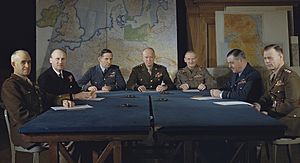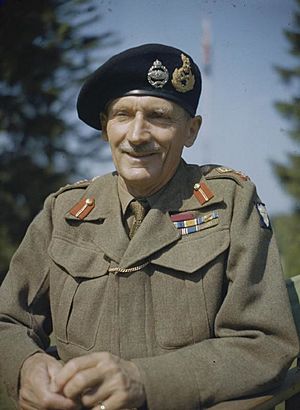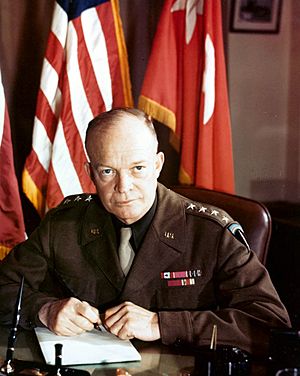Broad front versus narrow front controversy in World War II facts for kids

During World War II, a big debate happened in 1944 about how the Allied armies should advance into Germany. This was called the broad front versus narrow front controversy. General Dwight D. Eisenhower, the top Allied commander, decided to spread his forces out and advance on a "broad front." This meant attacking across a wide area.
However, some of his main commanders, like Omar Bradley, George S. Patton, and Bernard Montgomery, thought it would be better to focus on a "narrow front." This meant concentrating a lot of power in one or two main pushes. They believed this would end the war faster.
The decision was tricky for many reasons. The British government wanted their army to play a bigger role, and a strong British push towards Berlin seemed like a good way to show this. Montgomery, a British commander, strongly pushed for his idea, which caused some tension among the Allied leaders. Later, during the Cold War, some people wondered if Eisenhower's choice might have affected how much control the Soviet Union gained in Eastern Europe.
Eisenhower's decision was based on several important reasons. In late 1944, the Allies had problems getting enough supplies to their armies. There weren't enough working ports close to the front lines. Roads and railways were also struggling to move everything. Commanders worried about protecting long supply lines deep inside enemy territory, especially with many rivers to cross and bad weather affecting air support. Also, the areas of Germany that each Allied country would occupy after the war had already been decided in February 1944. A faster advance wouldn't have changed these agreements. The Soviet Union's help against Japan was also very important to the Allies.
Experts at Eisenhower's headquarters looked at both Montgomery's idea to push towards the Ruhr and Berlin, and Bradley's idea to advance on Metz and the Saarland. They thought both plans could work, but only if the port of Antwerp was opened quickly. They also needed a lot more air, rail, and road transport. Plus, other Allied armies needed to be ready at the German border. These conditions weren't met until much later in the year. If a narrow push had failed, the consequences could have been very bad.
Some historians, like A. J. P. Taylor, say that a book by Chester Wilmot started the idea that Eisenhower stopped Montgomery from winning the war in 1944. However, most historians today don't believe the war could have ended in 1944.
Contents
Why the Debate Started
On D-Day, June 6, 1944, the Allies invaded Normandy, France. They surprised the Germans and created a strong foothold. But the Germans fought hard in the difficult French countryside, called bocage. The Allied advance was slower and costlier than expected. A big storm in June also damaged one of the special temporary harbors the Allies built, showing how bad autumn weather could be. It seemed possible the war could get stuck, like in World War I. However, the Germans losing so many soldiers and equipment in Normandy meant their defeat there was certain.
On July 25, the Allies launched Operation Cobra and finally broke out of Normandy. By mid-August 1944, the Germans were retreating quickly. They were also falling back on other fronts, like in Southern France, Italy, and Belarus.
The First United States Army helped free Paris on August 25, 1944. Montgomery's forces began their own push on August 29. The First Canadian Army surrounded French Channel ports like Dieppe and Le Havre. The British 21st Army Group freed Brussels on September 4, 1944. The British Second Army advanced about 400 kilometers (250 miles) across France and Belgium to capture the port of Antwerp on September 4. However, the Germans still controlled the areas leading to the port. So, the port couldn't be used until the Scheldt estuary was cleared. It wasn't expected to be open until November 1. By September 1944, the Western Allies had reached Germany's western border, which was protected by the strong Siegfried Line.
The original plan for Operation Overlord was made in April 1944. The planners thought about advancing north of the Ardennes mountains. But they worried that many rivers would make it hard to use tanks. An advance towards Metz would be good for tanks, but the land would get rougher later and wouldn't threaten the important Ruhr industrial area. So, they suggested a main push towards the Ruhr, north of the Ardennes, with a smaller push south towards Metz.
The plan assumed the Germans would defend every major river. It also expected a steady, slow advance, not a fast chase of a disorganized enemy. The plan also included a month-long pause at the River Seine to set up supply bases. But in reality, the first seven weeks were very slow. Then, the Allies advanced much faster than expected in August. This meant their supply lines couldn't keep up. Railways and pipelines weren't built fast enough, and trucks struggled to deliver even basic needs.
Eisenhower took direct command of all ground forces on September 1. He commanded the Twelfth United States Army Group (led by Omar Bradley), which included the US First Army (led by Courtney Hodges) and the Third United States Army (led by George S. Patton Jr.). He also commanded the British 21st Army Group (led by Bernard Montgomery), which included the British Second Army (led by Miles Dempsey) and the First Canadian Army (led by Harry Crerar).
At Eisenhower's headquarters, everyone was very hopeful. They believed the Siegfried Line would be quickly overcome. In September 1944, the situation looked a lot like October and November 1918, when Germany asked for peace after losing battles. On September 5, Eisenhower wrote that the German armies were completely defeated. He felt that speed was the only thing needed now, but his supply lines were already stretched to their limit.
On September 4, Eisenhower told Bradley to focus the main effort north of the Ardennes. But Eisenhower usually let his army commanders decide how to carry out his plans. On September 5, he agreed that Patton's advance could continue. Bradley even gave Patton more fuel and divisions, taking them from other units. This led Eisenhower to give a clearer order on September 13. Patton crossed the Meuse river on September 14. But by the end of the month, both the First and Third Armies had stopped before reaching their goals.
Like the American generals, Montgomery's main goal was to defeat Germany quickly. But as the top British commander, he also faced political pressure. Britain's economy and manpower were struggling, so a victory in 1944 was better than one in 1945. He was eager to seize any chance for an early win, while Eisenhower was more realistic. On August 15, 1944, Eisenhower told reporters that anyone who thought the war would end soon was "crazy." He believed Hitler would fight to the very end.
Also, Britain needed to show it was playing a vital part in the war. This was important for its influence in the world after the war. If the British army suffered too many losses, Britain's power would be even smaller compared to the US and the Soviet Union. Montgomery was in a difficult spot: the British Army needed to be seen as doing a lot, but without taking too many casualties. The 21st Army Group didn't have enough forces to be the main attacker, so its divisions had to be used carefully.
Montgomery's solution was to ask to be put in charge of all Allied ground forces until the end of the war. This way, any victory, even if mostly achieved by American forces, would also be credited to him and Britain. He also wanted to make sure British units avoided the toughest battles but were prominent when the final blows were struck. When this didn't work, he asked Eisenhower to put some American forces under his command. This would boost his resources while still making it look like a successful British effort.
Supply Challenges
Many experts agree that logistics, or getting supplies to the troops, played a huge role in the war. General Eisenhower's decision in mid-September 1944 to use a "broad-front strategy" was largely because of supply issues. At first, it made sense to chase the retreating enemy. But there weren't enough trucks and other transport to deliver daily needs, let alone build up supply depots ahead of time. By September 12, the Allied armies had advanced much further than planned. They had covered 260 days of planned progress in just 19 days. This meant much larger forces were being supplied at much greater distances than expected. Also, Paris was freed 55 days early, and feeding its civilians added to the supply demands.
On August 3, Montgomery sent the US VIII Corps to take Brittany, saying it would be "enough." The US 6th Armored Division reached Brest by August 7. Brest was heavily defended by about 30,000 German troops. It was finally captured on September 20, but at a cost of about 10,000 American casualties. The city of Brest was completely destroyed, and the Germans had ruined the port. The river channel was blocked, and ships were sunk in the harbor. The smaller port of St. Malo was captured by September 2, but the Germans had also destroyed that port.
On September 7, Eisenhower decided to cancel a plan to build an artificial port in Brittany. By September 9, he decided that none of the Brittany ports were needed. This left the Americans relying only on the port of Cherbourg and the Normandy beaches, which were getting further and further away. Since railways and pipelines couldn't be built fast enough, American supplies depended on trucks. But even before the breakout from Normandy, there was a shortage of trucks. Special truck routes, like the Red Ball Express, helped but caused problems. Tires wore out, vehicles weren't properly maintained, and drivers were exhausted. By the end of September, 5,750 vehicles needed major repairs.
By mid-August, it was impossible to keep all available divisions fighting. By early September, three divisions had to stop moving so their trucks could be used for other units. It was estimated that no more than twenty divisions could be supplied as far as the Rhine by October 1. Bad weather would soon reduce the capacity of the beach landing zones even more. So, it was clear that pushing deep into Germany was not possible without more ways to get supplies.
By mid-September, the US First Army was fighting inside Germany, more than 320 kilometers (200 miles) beyond Paris. The original plan didn't expect them to reach that area until May 1945. So, they had to supply a huge force at a great distance, about 230 days earlier than planned.
Continuing the chase beyond the Seine river pushed the American supply system to its breaking point. This led to equipment wearing out, not enough supply depots being set up, and ports not being developed quickly enough. The American advance stopped in early September not because of a lack of fuel, but because they couldn't deliver it where it was needed. By September, with the weather getting worse, the supply command warned that it could only support one army. This meant stopping Patton's Third Army.
Eisenhower had been willing to delay capturing the Brittany ports earlier to destroy German forces. But such delays were no longer possible, especially with bad weather coming that would affect supplies from the beaches. Also, German resistance was getting stronger.
By September 9, the Brittany ports were 640 to 800 kilometers (400 to 500 miles) behind the front lines. Eisenhower decided they were no longer essential. Supply planners had suggested in early September that port development should focus on ports north of the Seine.
By the end of September, the supply command clearly stated that large-scale operations east of the Rhine were impossible. They didn't expect the port and transport situation to improve until mid-November. Large-scale operations wouldn't be possible until the port of Antwerp and enough railway lines were available.
Montgomery's Plan

On August 17, Montgomery flew to meet Bradley. Montgomery suggested that the original invasion plan should be changed. He wanted the 12th and 21st Army Groups to stay together as a huge force of about 40 divisions and advance north of the Ardennes. He later called this a "reverse Schlieffen Plan" (a famous German plan from World War I). Montgomery thought Bradley agreed with him. The next day, Montgomery sent a message to Alan Brooke, the top British general. He said that after crossing the Seine, the two army groups should stay together as a strong force. This force would move north, with the British on the west, to clear the Channel coast and secure Antwerp. The American armies would move towards Brussels, Aachen, and Cologne. This would cut off German forces on the coast and help the British. The goals were to destroy German forces on the coast, set up airfields in Belgium, and get the Germans out of range of England for their V-1 and V-2 rockets. He said Bradley agreed and that he would talk to Eisenhower after getting Brooke's reply.
Eisenhower met Montgomery for lunch on August 23. Montgomery presented his plan to Eisenhower. He warned that if they didn't take advantage of the good situation, the war in Europe would continue well into 1945. Montgomery argued that the 21st Army Group needed at least twelve American divisions to help. To provide supplies for them, he suggested stopping Patton's Third Army. In August and September 1944, the US First Army had nine divisions, so giving up twelve would have meant handing over almost the entire American army to Montgomery.
Bradley's Plan
When Montgomery met Bradley again on August 19, Bradley told him he was thinking about Patton's idea. This plan involved the main effort of the 12th Army Group being south of the Ardennes, towards Metz and the Saar. Bradley agreed that the Ruhr was important. But instead of the First Army surrounding it from the south near Cologne, as Montgomery suggested, Bradley thought it would be better for the Third Army to make a wider move around the Ruhr, crossing near Frankfurt. Bradley was a strong supporter of the "broad front" idea. He believed the German Army in the West was completely defeated, so he saw no reason to stop Patton's push towards the Saar, which he thought was a great opportunity.
What Happened Next
On September 17, Eisenhower stressed that a major deep-water port on the northern side was absolutely necessary for the final push into Germany. He said a large-scale push into the "enemy's heart" was impossible without opening Antwerp. He decided to advance on a broad front once enough supplies were available.
Eisenhower gave Montgomery permission to go ahead with Operation Market Garden. In this operation, airborne troops would try to capture a series of bridges, including one over the Rhine at Arnhem. Eisenhower saw this as a limited goal to secure a bridgehead over the Rhine. Operation Market Garden took place from September 17 to 25, 1944. It ended with a British defeat at the Battle of Arnhem because the ground forces were held up by German defenders and couldn't reach the airborne troops in time.

On September 18 and 21, while the Battle of Arnhem was still happening, Montgomery tried one last time to get his narrow front strategy approved. Again, Eisenhower rejected it. The outcome at Arnhem didn't settle the debate about a single push. Bradley still wanted advances in both the north and the south, but by September 21, he accepted that opening the port of Antwerp was necessary for future operations. As the planners had feared, the available supplies were not enough to support the broad front strategy.
Eisenhower held a meeting at Versailles the next day with 23 generals and admirals. Montgomery was the only important person missing, sending his chief of staff instead because of the critical situation at Arnhem. Eisenhower made his intentions clear. He stated that immediate operations would focus on breaking through the Siegfried Line and advancing on the Ruhr. He ordered Bradley to tell Montgomery about the decisions made at the meeting.
The defeat at Arnhem made it clear that the war would not end soon and that much hard fighting was still ahead. Bradley's forces got into costly battles at Aachen, the Hürtgen Forest, and Metz. In his decision for a broad front advance, Eisenhower considered political and strategic factors, as well as tactical and logistical ones. He thought about the political impact in an American election year and how favoring one nation might harm cooperation among the Allies. He knew Montgomery offered the exciting idea of an early victory, but he correctly judged that it was out of reach.
Operations to clear the Scheldt river began in October by the First Canadian Army. But it became clear they didn't have enough resources alone. On October 15, Eisenhower gave Montgomery a direct order to focus all his efforts on opening Antwerp. Eisenhower explained that this was absolutely necessary to support the American forces. The next day, Montgomery issued a new order to the 21st Army Group, making the opening of Antwerp a higher priority than advancing to the Rhine. He committed the British Second Army and the Canadian First Army to the battle. The battle ended on November 8, and minesweeping operations finished on November 26. Two days later, the first supply ship entered the port.
|

